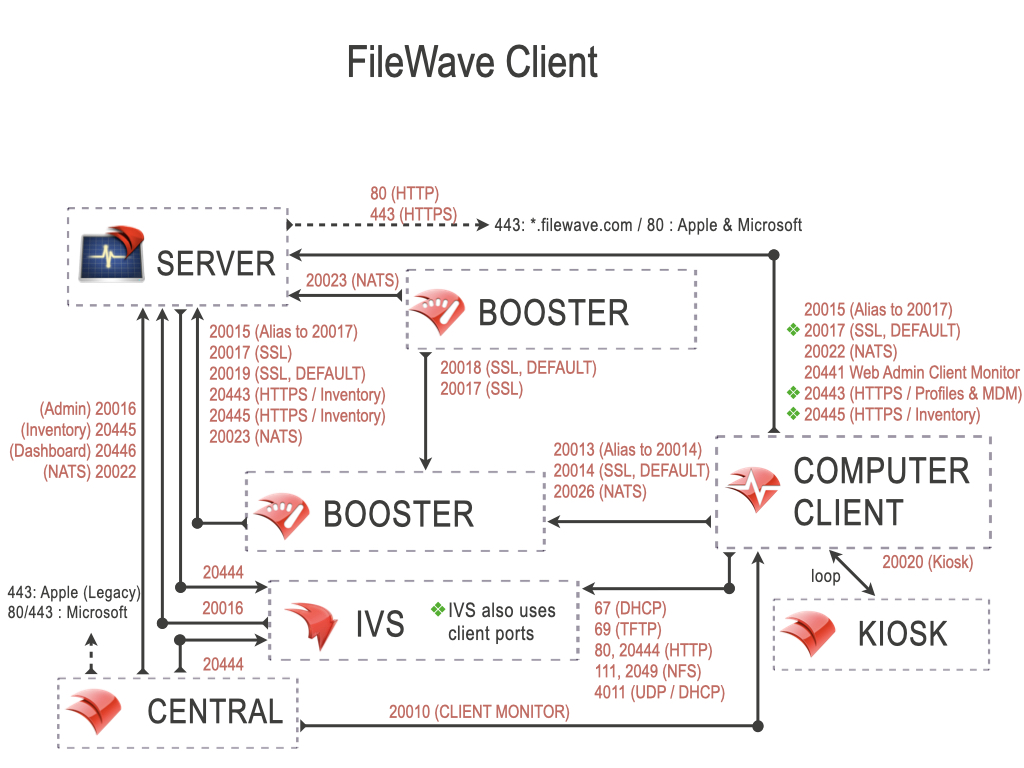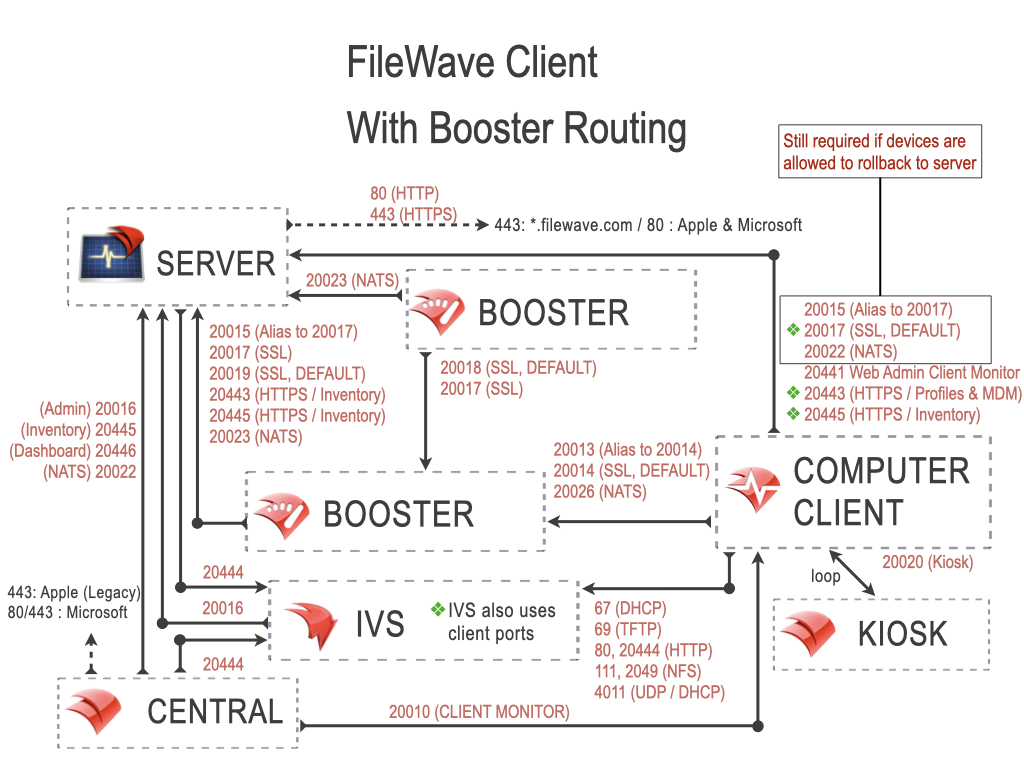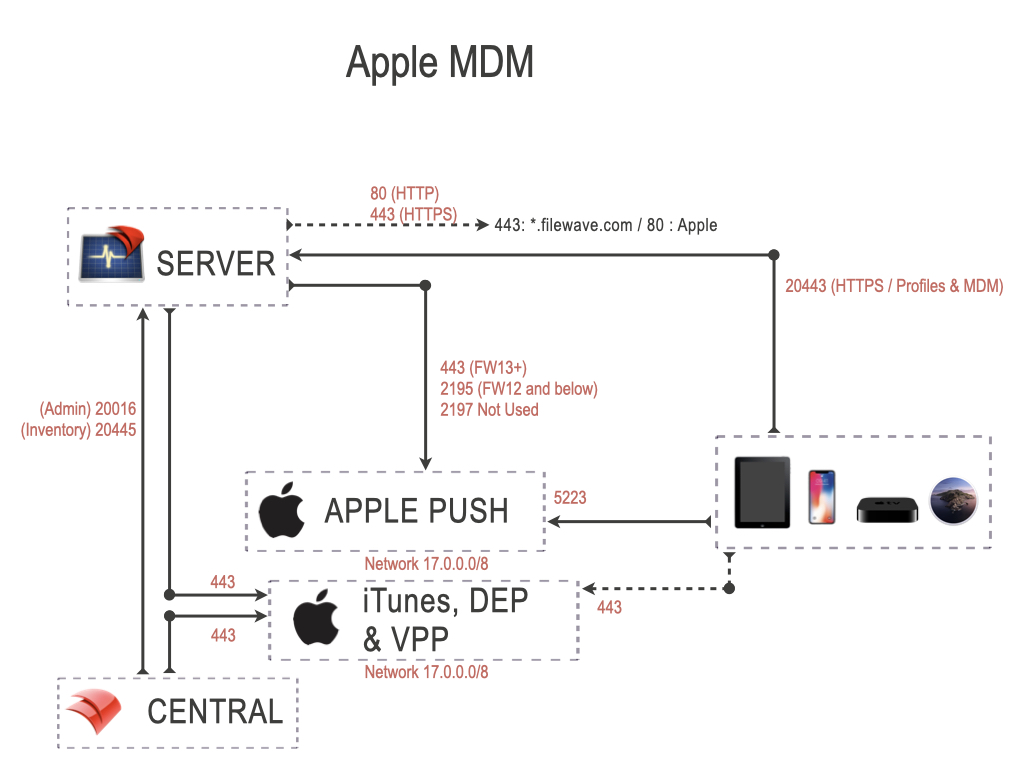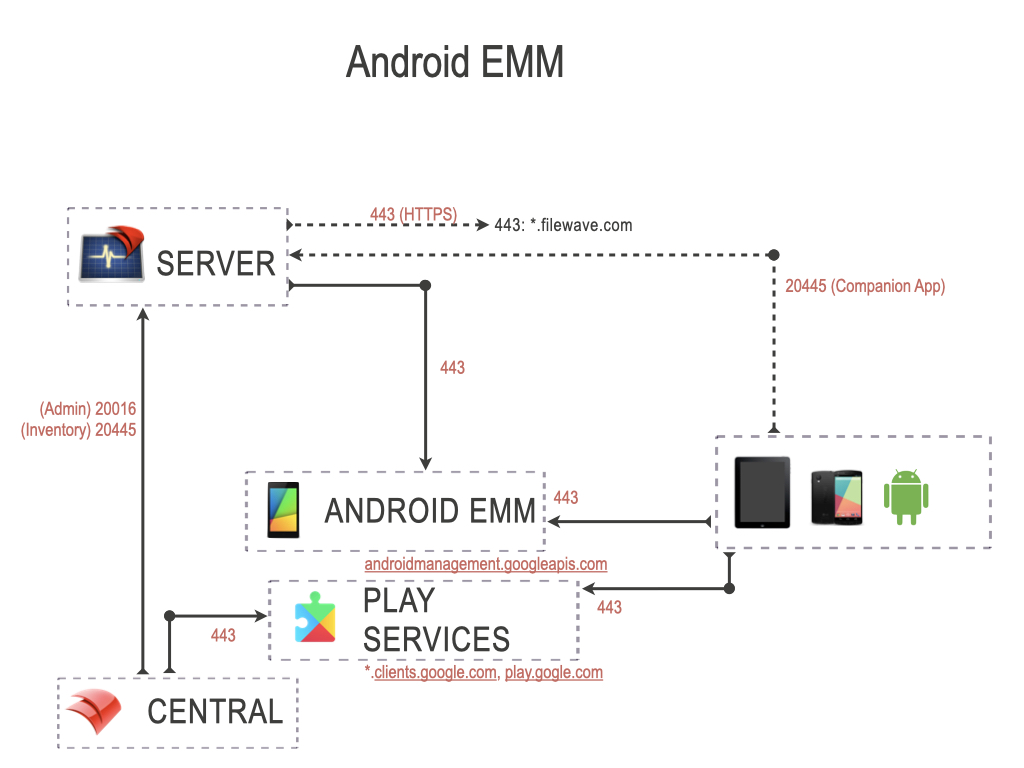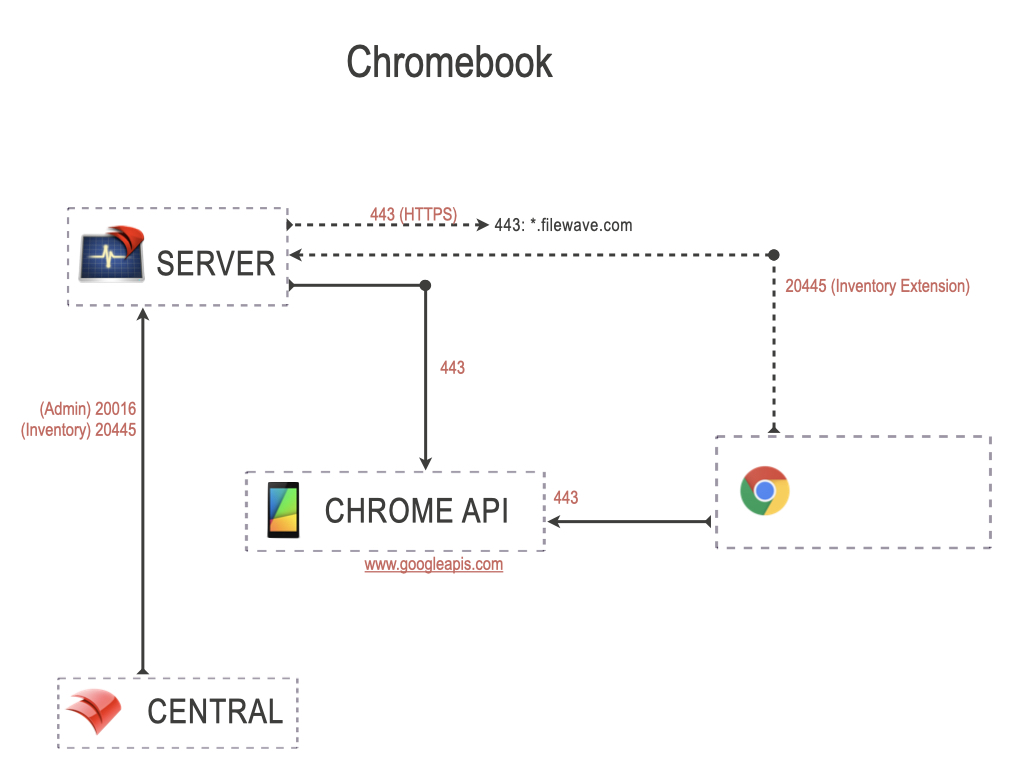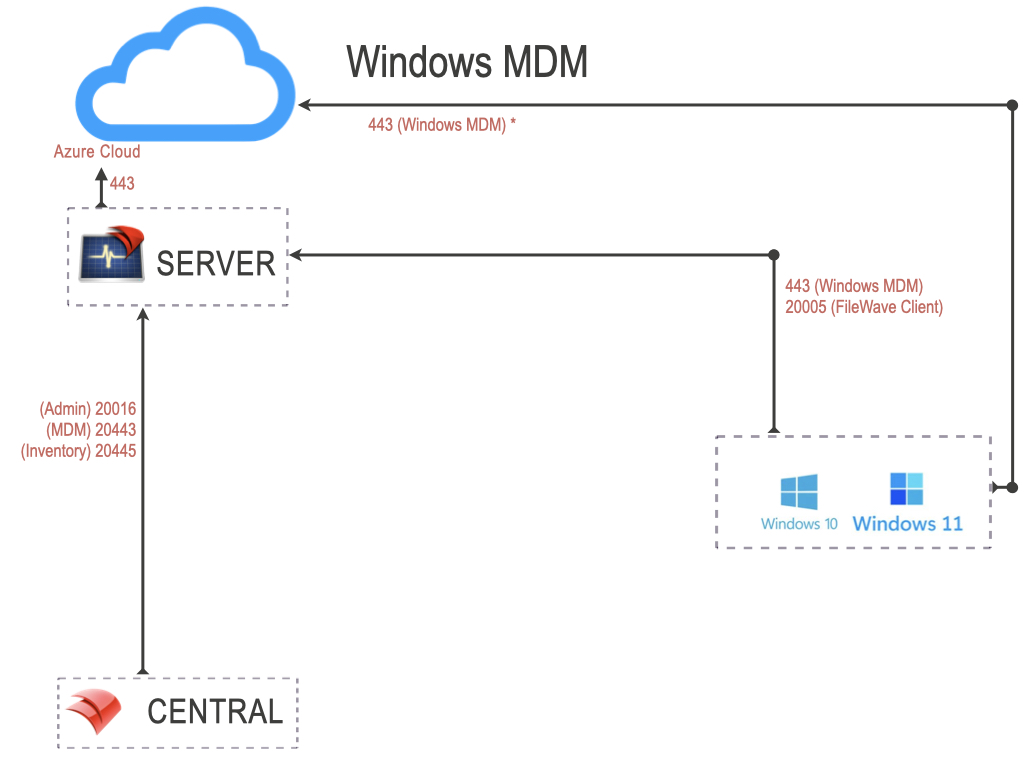Default TCP and UDP Port Usage
FileWave software uses the below-listed TCP/IP ports. These are default settings and may be configured to listen on different ports if required. You should also consider FileWave Server should not have IPv6 enabled for the best experience.
Port Testing
Port Testing Please consider downloading the FileWave Port Testing macOS/Windows utility to confirm communication of Google Cloud Messaging, Apple Push Notifications, and between the device network(s) and Server/Boosters.
The following may be run from the server to confirm Apple, Microsoft, and FileWave services:
Server Command Line
sudo /usr/local/filewave/python/bin/python /usr/local/filewave/django/manage.pyc check_connectionsTeamViewer Ports
TeamViewer has an additional set of ports to consider if you will be using it: https://community.teamviewer.com/English/kb/articles/4139-ports-used-by-teamviewer
FileWave Server Ports
Default Port 20445: MDM default port is 20445 as shown throughout this KB. On older versions of FileWave, this was 20443. To confirm the defined port, check the Port setting in FileWave Admin > Preferences > Mobile > MDM Server > Port
| Server Ports | Service | Protocol | Server In/Out | Description |
| 80 | HTTP | TCP | Outgoing |
FileWave Software Updates (apple.com & microsoft.com) *** |
| 443 | HTTPS | TCP | Outgoing | FileWave License Server (fwks.filewave.com & logstash.filewave.com)
FileWave Software Updates (apple.com) *** FileWave/TeamViewer Session Server (rcs.filewave.com) FileWave/TeamViewer Push Notification Server (fwpn.filewave.com) |
| 443 | HTTPS | TCP | Incoming | FileWave Anywhere API endpoints - Anywhere API (v2 API) |
| 20015 | Proprietary | TCP | Incoming | FileWave Client to Server; legacy (used for configuration only) |
| 20016 | SSL | TCP | Incoming | FileWave Admin to Server |
| 20017 | SSL | TCP | Incoming | FileWave Client to Server: Secure (replaces 20015) |
| 20019 | SSL | TCP | Incoming | Booster to Server: Priority Traffic |
| 20022 | SSL** | TCP | Incoming | FileWave Admin to Server: NATS
FileWave Client to Server: NATS IVS to Server: NATS |
| 20023 | SSL** | TCP | Incoming | FileWave Booster to Server: NATS |
| 20124 | SSL | TCP | Incoming | FileWave Server JSON Websockets (JWT) Websocket connections for NATS SERVER used between FW Anywhere and FW Server. (Added 14.10.0) |
| 20441 | Proprietary | TCP | Incoming | FileWave Client to Server: Remote Client Monitor |
| 20443 | HTTPS | TCP | Incoming | FileWave Client to Server: Profiles
Booster to Server: Inventory/Discovery |
| 20445 | HTTPS | TCP | Incoming | FileWave Client to Server: Inventory
Booster to Server: Inventory/Discovery |
| 20446 | HTTPS | TCP | Incoming | FileWave Admin and FileWave Anywhere to Dashboard |
* NATS includes: Remote Control Publishing, Remote Control Routing, device renaming, revoking device certificates, push notifications
** Only encrypted when compatibility mode is disabled
*** Also used by FileWave Central to vendor Software Update Servers.
FileWave Communication Diagram
Setting a client or booster port for server of 20015 will automatically set the SSL port as 20017 (port configured + 2)
Setting a client to booster port for 20013 will automatically set the SSL port as 20014 (port configured + 1)
Do not set the client or booster port for server as 20017 or client for booster port as 20014.
FileWave Client Ports
| Client Ports | Service | Protocol | Server In/Out | Description |
| 20010 | Proprietary | TCP | N/A | FileWave Admin to Client: Client Monitor: macOS, Windows & Android APK |
FileWave Client Port Diagram
FileWave Booster Ports
| Booster Ports | Service | Protocol | Server In/Out | Description |
| 20013 | Proprietary | TCP | Incoming | FileWave Client to Booster; legacy (used for configuration only) |
| 20014 | SSL | TCP | Incoming | FileWave Client to Booster: Secure (Booster Priority fallback) |
| 20018 | SSL | TCP | Incoming | Booster to Booster: Priority Traffic |
| 20026 | SSL †† | TCP | Incoming | FileWave Client to Booster connections using NATS Server |
† NATS includes: Remote Control Publishing, Remote Control Routing, device renaming, revoking device certificates, push notifications
†† Only encrypted when compatibility mode is disabled
FileWave Booster Port Diagram
Apple MDM Ports
| Apple MDM Ports | Service | Protocol | Server In/Out | Description |
| 443 | HTTPS | TCP | Outgoing |
FileWave Server to Apple's servers (17.0.0.0/8) FileWave Admin to iTunes, DEP & VPP (17.0.0.0/8) Device to iTunes, DEP & VPP (17.0.0.0/8) |
| 5223 | APNS | TCP | Outgoing | FileWave Server to Apple's servers (17.0.0.0/8) |
| 20443 | HTTPS | TCP | Incoming | Device to Server: Profiles & MDM |
| 20445 | HTTPS | TCP | Incoming | FileWave Admin to Server |
Apple MDM Port Diagram
Android EMM Ports
| Android EMM Ports | Service | Protocol | Server In/Out | Description |
| 443 | HTTPS | TCP | Outgoing |
Server to EMM commands (androidmanagement.googleapis.com) Device to Activation servers (*.clients.google.com) Device to Play Store (play.google.com) EMM commands (androidmanagement.googleapis.com) FileWave Admin to Play Store (play.google.com) |
| 20016 | SSL | TCP | Incoming | FileWave Admin to Server |
| 20445 | HTTPS | TCP | Incoming | FileWave Admin to Server: Inventory
Companion App to Server: Location Tracking |
Android EMM Port Diagram
Chromebook Ports
| Chromebook Ports | Service | Protocol | Server In/Out | Description |
| 443 | HTTPS | TCP | Outgoing |
Server to Chrome API Chromebook to Chrome API (www.googleapis.com) |
| 20016 | SSL | TCP | Incoming | FileWave Admin to Server |
| 20445 | HTTPS | TCP | Incoming |
FileWave Admin to Server Chromebook Inventory Extension to Server |
Chromebook Port Diagram
Windows MDM Ports
| Windows MDM Ports | Service | Protocol | Server In/Out | Description |
| 443 | HTTPS | TCP | Incoming | Device to Server (Enrollment URL) |
| 443 | HTTPS | TCP | Outgoing |
Server to Windows MDM (*.azure.com) Device to Windows MDM (*.azure.com) |
NOTE: The FileWave client will also install, and all previously listed FileWave client ports are also used.
Windows MDM Port Diagram
FileWave IVS Ports
| IVS (Imaging) Ports | Service | Protocol | Server In/Out | Description |
| 67 | DHCP | UDP | Client to IVS‡‡ | |
| 69 | TFTP | UDP | Client to IVS‡‡ | |
| 80 | HTTP | TCP | Client to IVS | |
| 111 | NFS | TCP/UDP | Client to IVS‡ | |
| 4011 | DHCP | TCP/UDP | Client to IVS: UEFI PXE‡ | |
| 2049 | NFS | TCP/UDP | Client to IVS‡ | |
| 20015 | Proprietary | TCP | Incoming | IVS to Server (Will be deprecated in a future release) |
| 20016 | SSL | TCP | Incoming | IVS to Server |
| 20017 | SSL | TCP | Incoming | IVS to Server: Secure (replaces 20015) |
| 20022 | SSL | TCP | Incoming | Imaging Server to FileWave Server NATS |
| 20443 | HTTPS | TCP | Incoming | IVS to Server: Inventory |
| 20444 | HTTPS | TCP | Incoming |
Server to IVS Client to IVS FileWave Anywhere interface (Appliance only) |
| 20445 | HTTPS | TCP | Incoming | IVS to Server: Inventory |
‡ TCP/IP & UDP
‡‡ UDP only
